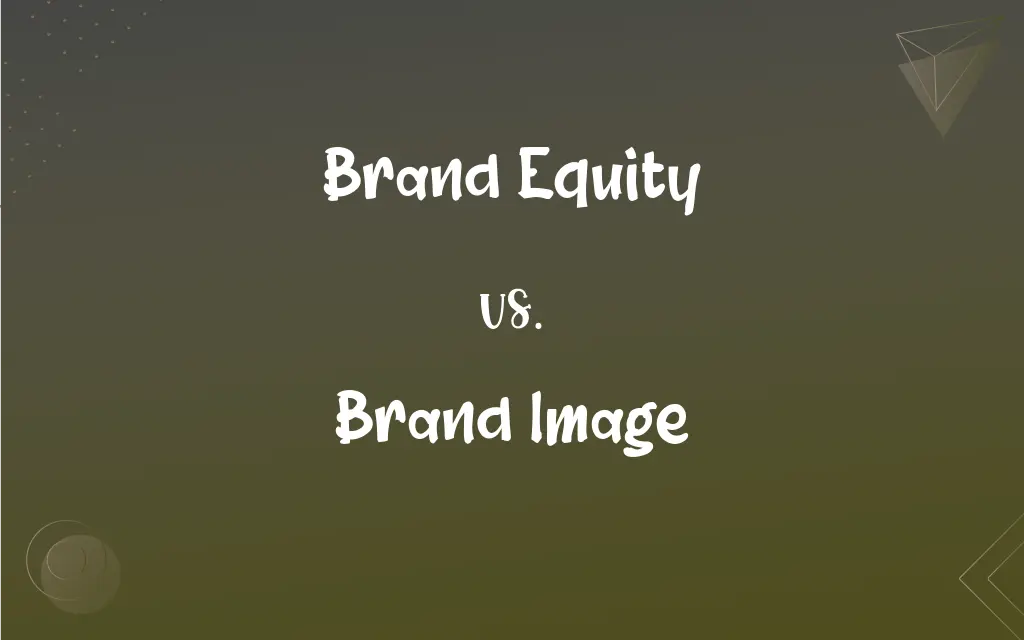Brand Equity vs. Brand Image: What's the Difference?
Edited by Aimie Carlson || By Janet White || Published on January 22, 2024
Brand equity is a brand's value from consumer perception, while brand image is the public's mental picture of a brand.

Key Differences
Brand equity refers to the value a brand holds, derived from consumers' experiences, perceptions, and associations. It is a cumulative outcome of a brand's efforts and consumer interactions, leading to customer loyalty and brand preference. On the other hand, brand image is the actual mental picture and set of beliefs that consumers hold about a brand. It is shaped by marketing efforts, word of mouth, and direct experiences with the brand.
Brand equity is built when consumers have positive experiences and perceptions, leading to higher trust and loyalty. It manifests in consumers' willingness to pay a premium for a brand or choose it over competitors. Brand image, however, is the immediate impression that comes to mind when consumers think of a brand. It encompasses the emotional and cognitive associations a consumer has with the brand, which may or may not align with the brand's intended image.
Brand equity significantly impacts a company's financial performance and market position. Strong brand equity can lead to increased market share, pricing power, and resilience during market fluctuations. Brand image, while influential, is more about consumer perceptions and can be more volatile, changing with new information or trends. The image is critical for attracting new customers and maintaining relevance in the market.
In developing brand equity, the focus is on long-term strategies such as consistent quality, customer service, and brand differentiation. Building brand equity is a strategic, cumulative process aiming for lasting customer relationships. In contrast, shaping brand image often involves more immediate marketing tactics, such as advertising campaigns, social media presence, and public relations, aiming to create a specific perception in the consumer's mind.
Measuring brand equity involves assessing financial metrics, market share, customer loyalty, and brand awareness. It requires a holistic approach, considering both tangible and intangible assets. Measuring brand image is more about gauging consumer attitudes, perceptions, and beliefs about the brand, often through market research, surveys, and social media analysis. Managing brand image is a dynamic process, requiring constant adaptation to consumer trends and market conditions.
ADVERTISEMENT
Comparison Chart
Definition
Value a brand holds from consumer perception
Public's mental picture of a brand
Key Focus
Building value and loyalty
Creating a specific perception
Influenced By
Consumer experiences, loyalty, brand strength
Marketing, public relations, consumer beliefs
Impact on Business
Affects financial performance, market share
Influences consumer attraction, relevance
Measurement and Management
Assessed by financial metrics, loyalty
Gauged by consumer attitudes, market research
ADVERTISEMENT
Brand Equity and Brand Image Definitions
Brand Equity
Brand equity is the consumer's perception of a brand's superiority.
Nike's brand equity is evident in its widespread popularity.
Brand Image
Brand image is how a brand is perceived in terms of reputation.
The brand image of Toyota is reliability and durability.
Brand Equity
Brand equity is the loyalty and preference a brand commands.
Coca-Cola's brand equity keeps customers returning.
Brand Image
Brand image is the consumer's mental picture of a brand.
The brand image of Rolex is synonymous with luxury.
Brand Equity
Brand equity is the added value a brand gains from its name.
The brand equity of Apple allows it to charge premium prices.
Brand Image
Brand image is the public's beliefs and impressions about a brand.
The brand image of Google is innovative and user-friendly.
Brand Equity
Brand equity is the financial benefit a brand possesses.
Disney's brand equity translates into higher box office sales.
Brand Image
Brand image is a reflection of a brand's marketing efforts.
McDonald's brand image is fun and family-friendly due to its marketing.
Brand Equity
Brand equity is a brand's differentiation in the market.
Tesla's brand equity distinguishes it in the electric vehicle market.
Brand Image
Brand image is the emotional connection consumers associate with a brand.
The brand image of Starbucks evokes a sense of community.
FAQs
How do you measure brand equity?
Brand equity is measured through market share, brand loyalty, consumer recognition, and financial metrics.
Can brand equity change?
Yes, brand equity can change based on market trends, consumer preferences, and company actions.
How is brand equity developed?
Brand equity develops over time through quality products, effective marketing, and positive consumer experiences.
What is brand equity?
Brand equity is the value and strength a brand acquires through consumers' positive perceptions and experiences.
How is brand image formed?
Brand image is formed by marketing efforts, consumer experiences, word of mouth, and media portrayal.
Why is brand equity important for a company?
Brand equity is important as it leads to customer loyalty, premium pricing ability, and competitive advantage.
Is brand image the same as brand identity?
No, brand identity is how a company presents itself, while brand image is how the public perceives it.
What is brand image?
Brand image is the public's perception and mental picture of a brand.
Why is brand image crucial?
Brand image is crucial as it affects consumer decisions, brand relevance, and the ability to attract new customers.
What role does advertising play in shaping brand image?
Advertising plays a key role in shaping brand image by conveying the brand's message and values to the public.
Can a brand recover from a damaged image?
Yes, a brand can recover from a damaged image through strategic actions, transparent communication, and rebuilding trust.
How do you improve a brand's image?
Improving a brand's image involves strategic marketing, quality products/services, and positive consumer interactions.
Can negative publicity impact brand image?
Yes, negative publicity can significantly harm a brand's image and consumer trust.
What is the relationship between brand equity and brand image?
Brand equity and brand image are interrelated; a positive brand image can enhance brand equity and vice versa.
How do consumer reviews impact brand image?
Consumer reviews can significantly impact brand image by influencing public perception and trust.
Can brand image be controlled by a company?
A company can influence brand image through marketing and public relations, but it can't fully control it.
Can a strong brand image lead to increased brand equity?
Yes, a strong brand image can lead to higher brand equity by building consumer trust and loyalty.
How do brand ambassadors influence brand equity?
Brand ambassadors can boost brand equity by enhancing brand visibility, credibility, and consumer connection.
How does social media affect brand image?
Social media can greatly influence brand image through customer feedback, viral content, and brand communication.
How does customer service affect brand equity?
Excellent customer service can enhance brand equity by improving customer satisfaction and loyalty.
About Author
Written by
Janet WhiteJanet White has been an esteemed writer and blogger for Difference Wiki. Holding a Master's degree in Science and Medical Journalism from the prestigious Boston University, she has consistently demonstrated her expertise and passion for her field. When she's not immersed in her work, Janet relishes her time exercising, delving into a good book, and cherishing moments with friends and family.
Edited by
Aimie CarlsonAimie Carlson, holding a master's degree in English literature, is a fervent English language enthusiast. She lends her writing talents to Difference Wiki, a prominent website that specializes in comparisons, offering readers insightful analyses that both captivate and inform.






































































